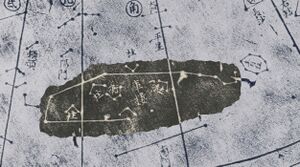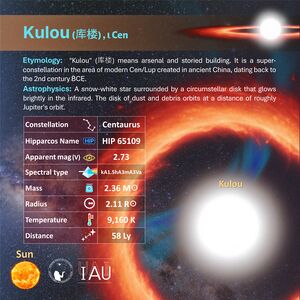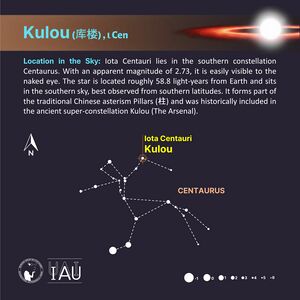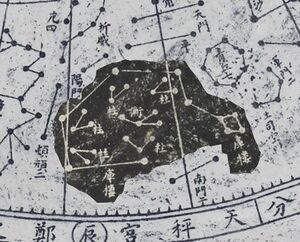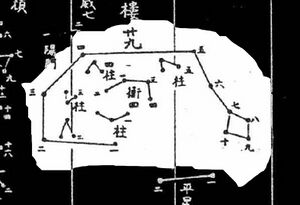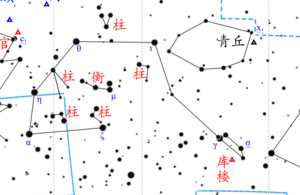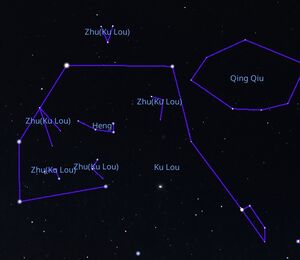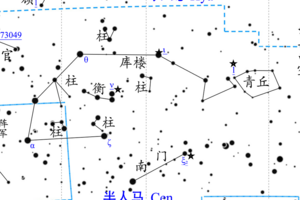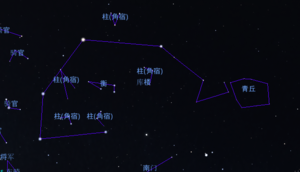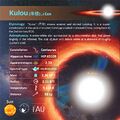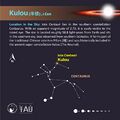Kulou: Difference between revisions
Boshunyang (talk | contribs) mNo edit summary |
No edit summary |
||
| (32 intermediate revisions by 3 users not shown) | |||
| Line 1: | Line 1: | ||
[[File:Kulou on the Suzhou Star |
[[File:Kulou on the Suzhou Star Map.jpg|alt=historical image of Kulou (China, Suzhou Map)|thumb|Kulou on the Suzhou Star Map]] |
||
[[File:Kulou profileCard SadeghFaghanpour-IAU-WGSN.jpg|thumb|Kulou profile card (CC BY Sadegh Faghanpour and Susanne M Hoffmann for IAU-WGSN).]] |
|||
Kulou, means arsenal and storied building, is a constellation created by ancient Chinese astrologers, dating back to the 2nd century BCE. It is classified as one of the "external" constellations (外官) of the Shi School (石氏), as it belongs to the Shi School's constellation system during the Han Dynasty, and it is outside of the 28 lunar mansions. |
|||
"Kulou" means arsenal and storied building, is a constellation in the area of modern [[Centaurus|Cen]]/[[Lupus|Lup]] created by ancient Chinese astrologers, dating back to the 2nd century BCE. It is classified as one of the "external" constellations (外官) of the Shi School (石氏), as it belongs to the Shi School's constellation system during the Han Dynasty, and it is outside of the 28 lunar mansions. |
|||
In 2025, the IAU adopted this constellation name as a star name for ι Cen. |
|||
== Contents == |
|||
{{DISPLAYTITLE:Kulou (库楼)}} |
|||
* 1Etymology and History |
|||
==Etymology and History== |
|||
** 1.1Identification of stars |
|||
Kulou includes various sub-constellations such as "'''Ku'''" (库, arsenal, 6 bright stars), "'''Lou'''" (楼, storehouse, 4 fainter stars), "'''Wu-Zhu'''" (五柱, literally 'five pillars,' but interpreted as military chariots in astrology, 3stars for each "pillar"), and "'''Heng'''" (衡, possibly the graduated arm of a steelyard weighing apparatus or the crossbar at the front of a chariot, 4 stars), totaling 29 stars. |
|||
** 1.2Maps (Gallery) |
|||
* 2Star Name Discussion (IAU) |
|||
* 3References |
|||
In the Western Han period, the names for Kulou were diverse, including "Tinaku (天库, celestial arsenal)," "Tian Kulou (天库楼, celestial arsenal and storied building)," and "Tian Lou (天楼, celestial storied building)" as referred to by Jiao Yanshou (1 century BCE), all of which are alternative names for "Kulou." |
|||
== Etymology and History == |
|||
Kulou includes various sub-constellations such as "Ku" (库, arsenal, 6 bright stars), "Lou" (楼, storied building, 4 fainter stars), "Wu-Zhu" (五柱, literally 'five pillars,' but interpreted as military chariots in astrology, 3stars for each "pillar"), and "Heng" (衡, possibly the graduated arm of a steelyard weighing apparatus or the crossbar at the front of a chariot, 4 stars), totaling 29 stars. |
|||
===Identification of stars=== |
|||
In the Western Han period, the names for Kulou were diverse, including "Tinaku(天库, celestial arsenal)," "Tian Kulou(天库楼, celestial arsenal and storied building)," and "Tian Lou(天楼, celestial storied building)" as referred to by Jiaoyan Shou(1 century BCE), all of which are alternative names for "Kulou." |
|||
[[File:Kulou stickfigure SadeghFaghanpour-IAU-WGSN.jpg|thumb|Kulou stickfigure (CC BY Sadegh Faghanpour and Susanne M Hoffmann for IAU-WGSN).]] |
|||
=== Identification of stars === |
|||
In Sima Qian's "''Book of Heavenly Officials''" (天官书), an early reference to Kulou is made, though the exact number of stars is not specified. The text provides a vague description: "南众星曰天库楼,库有五车" ("The southern group of stars is called Tian Kulou, with five chariots in the arsenal"), but it mentions "five chariots" instead of "five pillars," and makes no mention of Heng. Similarly, the "''Huangdi Zhan''" (黄帝占) follows the same naming convention, referring to Kulou as the "Outer Ku" (外库) and describing the five pillars as "Wu Che" (five chariots). This suggests that the early Ku Lou constellation's five pillars/chariots were likely all contained within the arsenal. |
In Sima Qian's "''Book of Heavenly Officials''" (天官书), an early reference to Kulou is made, though the exact number of stars is not specified. The text provides a vague description: "南众星曰天库楼,库有五车" ("The southern group of stars is called Tian Kulou, with five chariots in the arsenal"), but it mentions "five chariots" instead of "five pillars," and makes no mention of Heng. Similarly, the "''Huangdi Zhan''" (黄帝占) follows the same naming convention, referring to Kulou as the "Outer Ku" (外库) and describing the five pillars as "Wu Che" (five chariots). This suggests that the early Ku Lou constellation's five pillars/chariots were likely all contained within the arsenal. |
||
After the constellations were redefined during the Taichu |
After the constellations were redefined during the Taichu (104 BCE -102 BCE) period of the Western Han, the Kulou constellation was expanded to include "Heng," and one of the pillars was moved to the north of Kulou, as later Suzhou Star Map depict. Jiaoyan Shou's mention that "天楼星上近柱,王者楼殿有飞 (If the stars of Tian Lou go upwards to approach the pillar, indicating that the ruler's palace will fly (to other places))" seems to suggest that one of the pillars had indeed moved above Kulou. |
||
The primary star of this constellation is almost always Iota |
The primary star of this constellation is almost always Iota Centauri after the Han Dynasty. |
||
{| class="wikitable" |
{| class="wikitable" |
||
|+ |
|+ |
||
!Star Names or Orders(Traditional/Qing) |
!Star Names or Orders(Traditional/Qing) |
||
!Order(Qing Dynasty) |
|||
!Ho PENG YOKE<ref>P.-Y. Ho, “Ancient And Mediaeval Observations of Comets and Novae in Chinese Sources,” ''Vistas in Astronomy'', 5(1962), 127-225.</ref> |
!Ho PENG YOKE<ref>P.-Y. Ho, “Ancient And Mediaeval Observations of Comets and Novae in Chinese Sources,” ''Vistas in Astronomy'', 5(1962), 127-225.</ref> |
||
!Yi Shitong |
!Yi Shitong |
||
Based on catalogue in 18th century<ref>Yi Shitong伊世同. ''Zhongxi Duizhao Hengxing Tubiao''中西对照恒星图表1950. Beijing: Science Press.1981: 42-43.</ref> |
Based on catalogue in 18th century (Qing Dynasty)<ref>Yi Shitong伊世同. ''Zhongxi Duizhao Hengxing Tubiao''中西对照恒星图表1950. Beijing: Science Press.1981: 42-43.</ref> |
||
!Pan Nai |
!Pan Nai |
||
based on Xinyixiangfayao Star Map<ref>Pan Nai潘鼐. ''Zhongguo Hengxing Guance shi''中国恒星观测史[M]. Shanghai: Xuelin Pree. 2009. p308.</ref> |
based on Xinyixiangfayao Star Map<ref>Pan Nai潘鼐. ''Zhongguo Hengxing Guance shi''中国恒星观测史[M]. Shanghai: Xuelin Pree. 2009. p308.</ref> |
||
| Line 32: | Line 30: | ||
Han Dynasty<ref>Sun Xiaochun. & Kistemaker J. ''The Chinese sky during the Han''. Leiden: Brill. 1997, Pp241-6.</ref> |
Han Dynasty<ref>Sun Xiaochun. & Kistemaker J. ''The Chinese sky during the Han''. Leiden: Brill. 1997, Pp241-6.</ref> |
||
!Boshun Yang |
!Boshun Yang |
||
before Tang dynasty<ref>B.-S. Yang杨伯顺, ''Zhongguo Chuantong Hengxing Guance Jingdu ji Xingguan Yanbian Yanjiu'' 中国传统恒星观测精度及星官演变研究 (A Research on the Accuracy of Chinese Traditional Star Observation and the Evolution of Constellations), PhD thesis, (Hefei: University of Science and Technology of China, 2023). |
before Tang dynasty<ref name=":0">B.-S. Yang杨伯顺, ''Zhongguo Chuantong Hengxing Guance Jingdu ji Xingguan Yanbian Yanjiu'' 中国传统恒星观测精度及星官演变研究 (A Research on the Accuracy of Chinese Traditional Star Observation and the Evolution of Constellations), PhD thesis, (Hefei: University of Science and Technology of China, 2023). 250-251.</ref> |
||
!Boshun Yang |
!Boshun Yang |
||
Song Huangyou(1052)<ref name=":0" /> |
|||
Song Jingyou(1034)<ref>B.-S. Yang杨伯顺, ''Zhongguo Chuantong Hengxing Guance Jingdu ji Xingguan Yanbian Yanjiu'' 中国传统恒星观测精度及星官演变研究 (A Research on the Accuracy of Chinese Traditional Star Observation and the Evolution of Constellations), PhD thesis, (Hefei: University of Science and Technology of China, 2023). 2650-251.</ref> |
|||
|- |
|- |
||
| rowspan="6" |Ku |
| rowspan="6" |Ku |
||
| 1st/determinative |
|||
|zeta Cen |
|||
|zeta Cen |
| zeta Cen |
||
| zeta Cen |
|||
|iota Cen |
|||
|iota Cen |
|||
|iota Cen |
|||
|iota Cen |
|||
|- |
|||
|2nd |
|||
|eta Cen |
|||
|eta Cen |
|||
|upsilon1 Cen |
|upsilon1 Cen |
||
|epsilon Cen |
|epsilon Cen |
||
| Line 44: | Line 51: | ||
|zeta Cen |
|zeta Cen |
||
|- |
|- |
||
|3rd |
|||
|eta Cen |
|||
| |
|theta Cen |
||
| |
|theta Cen |
||
|eta Cen |
|||
|alpha Lup |
|alpha Lup |
||
|alpha Lup |
|alpha Lup |
||
|alpha Lup |
|alpha Lup |
||
|- |
|- |
||
|4th |
|||
|theta Cen |
|||
| |
|g Cen |
||
|g Cen |
|||
|theta Cen |
|theta Cen |
||
|eta Cen |
|eta Cen |
||
| Line 58: | Line 67: | ||
|eta Cen |
|eta Cen |
||
|- |
|- |
||
|5th |
|||
|g Cen |
|||
| |
|d Cen |
||
| |
|d Cen |
||
|g Cen |
|||
|theta Cen |
|theta Cen |
||
|theta Cen |
|theta Cen |
||
|theta Cen |
|theta Cen |
||
|- |
|- |
||
|6th |
|||
|d Cen |
|||
| |
|e Cen |
||
|iota Cen |
|||
|iota Cen |
|||
|iota Cen |
|||
|iota Cen |
|||
|- |
|||
|e Cen |
|||
|f Cen |
|f Cen |
||
|HIP 64408 |
|HIP 64408 |
||
|gamma Cen |
|gamma Cen |
||
|HIP 64348 |
|HIP 64348 |
||
|HIP 64408 |
|HIP 64408 |
||
|- |
|- |
||
| rowspan="4" |Lou |
| rowspan="4" |Lou |
||
|7th |
|||
|gamma Cen |
|gamma Cen |
||
|gamma Cen |
| gamma Cen |
||
|HIP 63972 |
|HIP 63972 |
||
|alpha Cru |
|alpha Cru |
||
|gamma Cen |
|gamma Cen |
||
|n Cen |
|n Cen |
||
|- |
|- |
||
|8th |
|||
|sigma Cen |
|||
| |
|tau Cen |
||
|tau Cen |
|||
|HIP 64332A |
|||
| HIP 64332A |
|||
|Beta Cru |
|Beta Cru |
||
|tau Cen |
|tau Cen |
||
|HIP 63066 |
|HIP 63066 |
||
|- |
|- |
||
|9th |
|||
|E Cen |
|||
| E Cen |
|||
|HIP 60517 |
|HIP 60517 |
||
|HIP 64557 |
|HIP 64557 |
||
|gamma Cru |
| gamma Cru |
||
|G Cen |
|G Cen |
||
|HIP 64468 |
|HIP 64468 |
||
|- |
|- |
||
|10th |
|||
|tau Cen |
|||
| |
|sigma Cen |
||
| sigma Cen |
|||
|HIP 64348 |
|HIP 64348 |
||
|delta Cru |
|delta Cru |
||
| Line 109: | Line 118: | ||
|- |
|- |
||
| rowspan="4" |Heng |
| rowspan="4" |Heng |
||
|1st/determinative |
|||
|nu Cen |
|nu Cen |
||
|nu Cen |
|nu Cen |
||
| Line 114: | Line 124: | ||
|nu Cen |
|nu Cen |
||
|nu Cen |
|nu Cen |
||
|nu Cen |
|nu Cen |
||
|- |
|- |
||
|2nd |
|||
|mu Cen |
|mu Cen |
||
|mu Cen |
|mu Cen |
||
|mu Cen |
|mu Cen |
||
|mu Cen |
|mu Cen |
||
|mu Cen |
| mu Cen |
||
|mu Cen |
| mu Cen |
||
|- |
|- |
||
|3rd |
|||
|phi Cen |
|||
|phi Cen |
|||
|phi Cen |
|||
|phi Cen |
|||
|phi Cen |
|||
|phi Cen |
|||
|- |
|||
|4th |
|||
|chi Cen |
|chi Cen |
||
|chi Cen |
|chi Cen |
||
| Line 130: | Line 150: | ||
|chi Cen |
|chi Cen |
||
|- |
|- |
||
| rowspan="3" |Zhu |
|||
|phi Cen |
|||
|1st |
|||
|phi Cen |
|||
| |
| upsilon2 Cen |
||
| |
| upsilon2 Cen |
||
| |
| zeta Cen |
||
| |
|upsilon2 Cen |
||
|upsilon2 Cen |
|||
|upsilon2 Cen |
|||
|- |
|- |
||
|2nd |
|||
| rowspan="3" |Zhu |
|||
|upsilon1 Cen |
|upsilon1 Cen |
||
|upsilon1 Cen |
|upsilon1 Cen |
||
| Line 144: | Line 166: | ||
|upsilon1 Cen |
|upsilon1 Cen |
||
|upsilon1 Cen |
|upsilon1 Cen |
||
|- |
|||
|upsilon2 Cen |
|||
|upsilon2 Cen |
|||
|zeta Cen |
|||
|upsilon2 Cen |
|||
|upsilon2 Cen |
|||
|upsilon2 Cen |
|||
|- |
|- |
||
| |
|||
| |
| |
||
| |
| |
||
| Line 160: | Line 176: | ||
|- |
|- |
||
| rowspan="3" |Zhu |
| rowspan="3" |Zhu |
||
| |
|3rd |
||
|iota Lup |
|||
|iota Lup |
|iota Lup |
||
|iota Lup |
|iota Lup |
||
|rho Lup |
|rho Lup |
||
|iota Lup |
|iota Lup |
||
|iota Lup |
|iota Lup |
||
|- |
|- |
||
|4th |
|||
|tau1 Lup |
|tau1 Lup |
||
|tau1 Lup |
| tau1 Lup |
||
|tau1 Lup |
|tau1 Lup |
||
|sigma Luo |
|sigma Luo |
||
| Line 174: | Line 192: | ||
|tau1 Lup |
|tau1 Lup |
||
|- |
|- |
||
| |
|||
| |
| |
||
| |
| |
||
| Line 179: | Line 198: | ||
|HIP 70931 |
|HIP 70931 |
||
|HIP 70104 |
|HIP 70104 |
||
|HIP 70104 |
| HIP 70104 |
||
|- |
|- |
||
| rowspan="3" |Zhu |
| rowspan="3" |Zhu |
||
|5th |
|||
|a Cen |
|||
|a Cen |
|a Cen |
||
|a Cen |
|a Cen |
||
|a Cen |
|||
|iota Lup |
|iota Lup |
||
|a Cen |
| a Cen |
||
|a Cen |
|a Cen |
||
|- |
|- |
||
|6th |
|||
|psi Cen |
|psi Cen |
||
|psi Cen |
|psi Cen |
||
| Line 196: | Line 217: | ||
|HIP 69598 |
|HIP 69598 |
||
|- |
|- |
||
| |
|||
| |
| |
||
| |
| |
||
| Line 201: | Line 223: | ||
|HIP 70104 |
|HIP 70104 |
||
|HIP 70054 |
|HIP 70054 |
||
|HIP 70054 |
| HIP 70054 |
||
|- |
|- |
||
| rowspan="3" |Zhu |
| rowspan="3" | Zhu |
||
|7th |
|||
|h Cen |
|||
|h Cen |
|h Cen |
||
|h Cen |
| h Cen |
||
| |
| a Cen |
||
|a Cen |
|||
|k Cen |
|k Cen |
||
|k Cen |
|k Cen |
||
|- |
|- |
||
|8th |
|||
|k Cen |
|k Cen |
||
|k Cen |
|k Cen |
||
|k Cen |
| k Cen |
||
|psi Cen |
| psi Cen |
||
|i Cen |
|i Cen |
||
|i Cen |
|i Cen |
||
|- |
|- |
||
| |
| 9th |
||
|i Cen |
|||
|i Cen |
|i Cen |
||
|i Cen |
|i Cen |
||
|HIP 70987 |
|HIP 70987 |
||
|g Cen |
| g Cen |
||
|g Cen |
|g Cen |
||
|- |
|- |
||
| rowspan="3" |Zhu |
| rowspan="3" |Zhu |
||
|10th |
|||
|iota Cen |
|||
|HIP 64003 |
|||
|iota Cen |
|||
|? |
|||
|d Cen |
|d Cen |
||
|k Cen |
|k Cen |
||
|d Cen |
| d Cen |
||
|d Cen |
|d Cen |
||
|- |
|- |
||
|11th |
|||
|HIP 64003 |
|||
|iota Cen |
|||
|? |
|||
|iota Cen |
|||
|HIP 65535 |
|HIP 65535 |
||
|i Cen |
|i Cen |
||
|HIP 65535 |
|HIP 65535 |
||
|HIP 65535 |
|HIP 65535 |
||
|- |
|- |
||
| |
|||
| |
| |
||
| |
| |
||
| Line 248: | Line 276: | ||
|} |
|} |
||
=== |
===Maps=== |
||
{| class="wikitable" |
|||
<gallery widths="200" perrow="3" caption="Kulou"> |
|||
|+ |
|||
File:Kulou on the Cheonsang Yeolcha Bunyajido Star Chart.jpg|Kulou on the Cheonsang Yeolcha Bunyajido Star Chart |
|||
!historical map |
|||
File:Kulou on the Geziyuejintu(Tang Dynasty).jpg|Kulou on the Geziyuejintu(Tang Dynasty) |
|||
!modern identification |
|||
File:Kulou on the Suzhou Star Chart.jpg|Kulou on the Suzhou Star Chart |
|||
(Yang 2023) |
|||
!same in Stellarium 24.4 |
|||
|- |
|||
|[[File:Kulou on the Cheonsang Yeolcha Bunyajido Star Chart.jpg|alt=historical image of Kulou (Korea)|thumb|Kulou on the Cheonsang Yeolcha Bunyajido Star Chart]] |
|||
| |
|||
| |
|||
|- |
|||
|[[File:Kulou on the Geziyuejintu(Tang Dynasty).jpg|alt=historical image of Kulou (Chinese Tang Dynasty)|thumb|Kulou on the Geziyuejintu(Tang Dynasty)]] |
|||
|[[File:Kulou Tang+Korea Yang2023.png|alt=modern star chart displaying the identification|thumb|Kulou between Han and Tang Dynasty as drawn on the ''Cheonsang Yeocha Bunyajido'' and ''Geziyuejintu'', identified by Boshun Yang (2023).]] |
|||
|[[File:Kulou in Han and Tang dynasty shown in Stellarium (based on Yang 2023).jpg|thumb|Kulou between Han and Tang Dynasty as drawn on the ''Cheonsang Yeocha Bunyajido'' and ''Geziyuejintu'', mapped in Stellarium 2024 by Boshun Yang (2023)]] |
|||
|- |
|||
|[[File:Kulou on the Suzhou Star Map.jpg|alt=historical image of Kulou (China, Suzhou Map)|thumb|Kulou on the Suzhou Star Map]] |
|||
|[[File:Kulou Suzhou Yang2023.png|alt=modern star chart displaying the identification|thumb|Kulou as drawn on the Suzhou map in Song Dynasty (China), identified by Boshun Yang (2023).]] |
|||
|[[File:Kulou Suzhou Stellarium2024.png|alt=modern star chart displaying the identification (Stellarium)|thumb|Kulou as drawn on the famous Suzhou Star Chart from Song Dynasty China, mapped in Stellarium (not published) by Boshun Yang (2023).]] |
|||
|} |
|||
==IAU Working Group on Star Names== |
|||
In 2023, the name of the historical constellation was suggested to be used for one of the stars in this constellation. The determinative star of '''Kulou''' is I'''ota Centauri,''' ι Cen (2.73 mag, triple A-type star [https://simbad.u-strasbg.fr/simbad/sim-id?Ident=iota+Cen&NbIdent=1&Radius=2&Radius.unit=arcmin&submit=submit+id SIMBAD]) and would therefore be the first choice. |
|||
Furthermore, there are some subsidiary this constellation, such as '''Heng'''. "Heng" should become the star name for its determinative star, ν '''Cen''' (V=3.386 mag, betaCep-variable, [https://simbad.cds.unistra.fr/simbad/sim-basic?Ident=nu+Cen&submit=SIMBAD+search SIMBAD], slightly variable [https://www.aavso.org/vsx/index.php?view=detail.top&oid=8349 between 3.40 and 3.42 mag]). |
|||
Decision: The name was adopted by the IAU WGSN on 2025/02/17. It is the name of HIP65109 (ι Cen, HR 5028) in constellation Cen.<gallery> |
|||
File:Kulou profileCard SadeghFaghanpour-IAU-WGSN.jpg |
|||
File:Kulou stickfigure SadeghFaghanpour-IAU-WGSN.jpg |
|||
</gallery> |
</gallery> |
||
==References== |
|||
== Star Name Discussion (IAU) == |
|||
In 202x, the name of the historical constellation "xxx" was suggested to be used for one of the stars in this constellation. ... |
|||
<references /> |
|||
*[[References (Chinese)|All Chinese References]] |
|||
Decision: ... |
|||
[[Category:Asterism ]] |
|||
== References == |
|||
[[Category:Constellation ]] |
|||
[[Category:Eurasia]] |
|||
[[Category:East Asian]] |
|||
[[Category:Chinese ]] |
|||
[[Category:Cen]] |
|||
[[Category:Lup]] |
|||
[[Category:IAU-Star Name]] |
|||
Latest revision as of 07:27, 29 November 2025
"Kulou" means arsenal and storied building, is a constellation in the area of modern Cen/Lup created by ancient Chinese astrologers, dating back to the 2nd century BCE. It is classified as one of the "external" constellations (外官) of the Shi School (石氏), as it belongs to the Shi School's constellation system during the Han Dynasty, and it is outside of the 28 lunar mansions.
In 2025, the IAU adopted this constellation name as a star name for ι Cen.
Etymology and History
Kulou includes various sub-constellations such as "Ku" (库, arsenal, 6 bright stars), "Lou" (楼, storehouse, 4 fainter stars), "Wu-Zhu" (五柱, literally 'five pillars,' but interpreted as military chariots in astrology, 3stars for each "pillar"), and "Heng" (衡, possibly the graduated arm of a steelyard weighing apparatus or the crossbar at the front of a chariot, 4 stars), totaling 29 stars.
In the Western Han period, the names for Kulou were diverse, including "Tinaku (天库, celestial arsenal)," "Tian Kulou (天库楼, celestial arsenal and storied building)," and "Tian Lou (天楼, celestial storied building)" as referred to by Jiao Yanshou (1 century BCE), all of which are alternative names for "Kulou."
Identification of stars
In Sima Qian's "Book of Heavenly Officials" (天官书), an early reference to Kulou is made, though the exact number of stars is not specified. The text provides a vague description: "南众星曰天库楼,库有五车" ("The southern group of stars is called Tian Kulou, with five chariots in the arsenal"), but it mentions "five chariots" instead of "five pillars," and makes no mention of Heng. Similarly, the "Huangdi Zhan" (黄帝占) follows the same naming convention, referring to Kulou as the "Outer Ku" (外库) and describing the five pillars as "Wu Che" (five chariots). This suggests that the early Ku Lou constellation's five pillars/chariots were likely all contained within the arsenal.
After the constellations were redefined during the Taichu (104 BCE -102 BCE) period of the Western Han, the Kulou constellation was expanded to include "Heng," and one of the pillars was moved to the north of Kulou, as later Suzhou Star Map depict. Jiaoyan Shou's mention that "天楼星上近柱,王者楼殿有飞 (If the stars of Tian Lou go upwards to approach the pillar, indicating that the ruler's palace will fly (to other places))" seems to suggest that one of the pillars had indeed moved above Kulou.
The primary star of this constellation is almost always Iota Centauri after the Han Dynasty.
| Star Names or Orders(Traditional/Qing) | Order(Qing Dynasty) | Ho PENG YOKE[1] | Yi Shitong
Based on catalogue in 18th century (Qing Dynasty)[2] |
Pan Nai
based on Xinyixiangfayao Star Map[3] |
SUN X. & J. Kistemaker
Han Dynasty[4] |
Boshun Yang
before Tang dynasty[5] |
Boshun Yang
Song Huangyou(1052)[5] |
|---|---|---|---|---|---|---|---|
| Ku | 1st/determinative | zeta Cen | zeta Cen | iota Cen | iota Cen | iota Cen | iota Cen |
| 2nd | eta Cen | eta Cen | upsilon1 Cen | epsilon Cen | zeta Cen | zeta Cen | |
| 3rd | theta Cen | theta Cen | eta Cen | alpha Lup | alpha Lup | alpha Lup | |
| 4th | g Cen | g Cen | theta Cen | eta Cen | eta Cen | eta Cen | |
| 5th | d Cen | d Cen | g Cen | theta Cen | theta Cen | theta Cen | |
| 6th | e Cen | f Cen | HIP 64408 | gamma Cen | HIP 64348 | HIP 64408 | |
| Lou | 7th | gamma Cen | gamma Cen | HIP 63972 | alpha Cru | gamma Cen | n Cen |
| 8th | tau Cen | tau Cen | HIP 64332A | Beta Cru | tau Cen | HIP 63066 | |
| 9th | E Cen | HIP 60517 | HIP 64557 | gamma Cru | G Cen | HIP 64468 | |
| 10th | sigma Cen | sigma Cen | HIP 64348 | delta Cru | sigma Cen | l Cen | |
| Heng | 1st/determinative | nu Cen | nu Cen | nu Cen | nu Cen | nu Cen | nu Cen |
| 2nd | mu Cen | mu Cen | mu Cen | mu Cen | mu Cen | mu Cen | |
| 3rd | phi Cen | phi Cen | phi Cen | phi Cen | phi Cen | phi Cen | |
| 4th | chi Cen | chi Cen | chi Cen | chi Cen | chi Cen | chi Cen | |
| Zhu | 1st | upsilon2 Cen | upsilon2 Cen | zeta Cen | upsilon2 Cen | upsilon2 Cen | upsilon2 Cen |
| 2nd | upsilon1 Cen | upsilon1 Cen | HIP 67663 | upsilon1 Cen | upsilon1 Cen | upsilon1 Cen | |
| upsilon2 Cen | zeta Cen | HIP 68079 | HIP 68079 | ||||
| Zhu | 3rd | iota Lup | iota Lup | iota Lup | rho Lup | iota Lup | iota Lup |
| 4th | tau1 Lup | tau1 Lup | tau1 Lup | sigma Luo | tau1 Lup | tau1 Lup | |
| HIP 70104 | HIP 70931 | HIP 70104 | HIP 70104 | ||||
| Zhu | 5th | a Cen | a Cen | a Cen | iota Lup | a Cen | a Cen |
| 6th | psi Cen | psi Cen | psi Cen | tau1 Lup | HIP 69598 | HIP 69598 | |
| HIP 68493 | HIP 70104 | HIP 70054 | HIP 70054 | ||||
| Zhu | 7th | h Cen | h Cen | h Cen | a Cen | k Cen | k Cen |
| 8th | k Cen | k Cen | k Cen | psi Cen | i Cen | i Cen | |
| 9th | i Cen | i Cen | i Cen | HIP 70987 | g Cen | g Cen | |
| Zhu | 10th | HIP 64003 | ? | d Cen | k Cen | d Cen | d Cen |
| 11th | iota Cen | iota Cen | HIP 65535 | i Cen | HIP 65535 | HIP 65535 | |
| HIP 65593 | g Cen | HIP 65593 | HIP 65593 |
Maps
| historical map | modern identification
(Yang 2023) |
same in Stellarium 24.4 |
|---|---|---|
IAU Working Group on Star Names
In 2023, the name of the historical constellation was suggested to be used for one of the stars in this constellation. The determinative star of Kulou is Iota Centauri, ι Cen (2.73 mag, triple A-type star SIMBAD) and would therefore be the first choice.
Furthermore, there are some subsidiary this constellation, such as Heng. "Heng" should become the star name for its determinative star, ν Cen (V=3.386 mag, betaCep-variable, SIMBAD, slightly variable between 3.40 and 3.42 mag).
Decision: The name was adopted by the IAU WGSN on 2025/02/17. It is the name of HIP65109 (ι Cen, HR 5028) in constellation Cen.
References
- ↑ P.-Y. Ho, “Ancient And Mediaeval Observations of Comets and Novae in Chinese Sources,” Vistas in Astronomy, 5(1962), 127-225.
- ↑ Yi Shitong伊世同. Zhongxi Duizhao Hengxing Tubiao中西对照恒星图表1950. Beijing: Science Press.1981: 42-43.
- ↑ Pan Nai潘鼐. Zhongguo Hengxing Guance shi中国恒星观测史[M]. Shanghai: Xuelin Pree. 2009. p308.
- ↑ Sun Xiaochun. & Kistemaker J. The Chinese sky during the Han. Leiden: Brill. 1997, Pp241-6.
- ↑ 5.0 5.1 B.-S. Yang杨伯顺, Zhongguo Chuantong Hengxing Guance Jingdu ji Xingguan Yanbian Yanjiu 中国传统恒星观测精度及星官演变研究 (A Research on the Accuracy of Chinese Traditional Star Observation and the Evolution of Constellations), PhD thesis, (Hefei: University of Science and Technology of China, 2023). 250-251.
